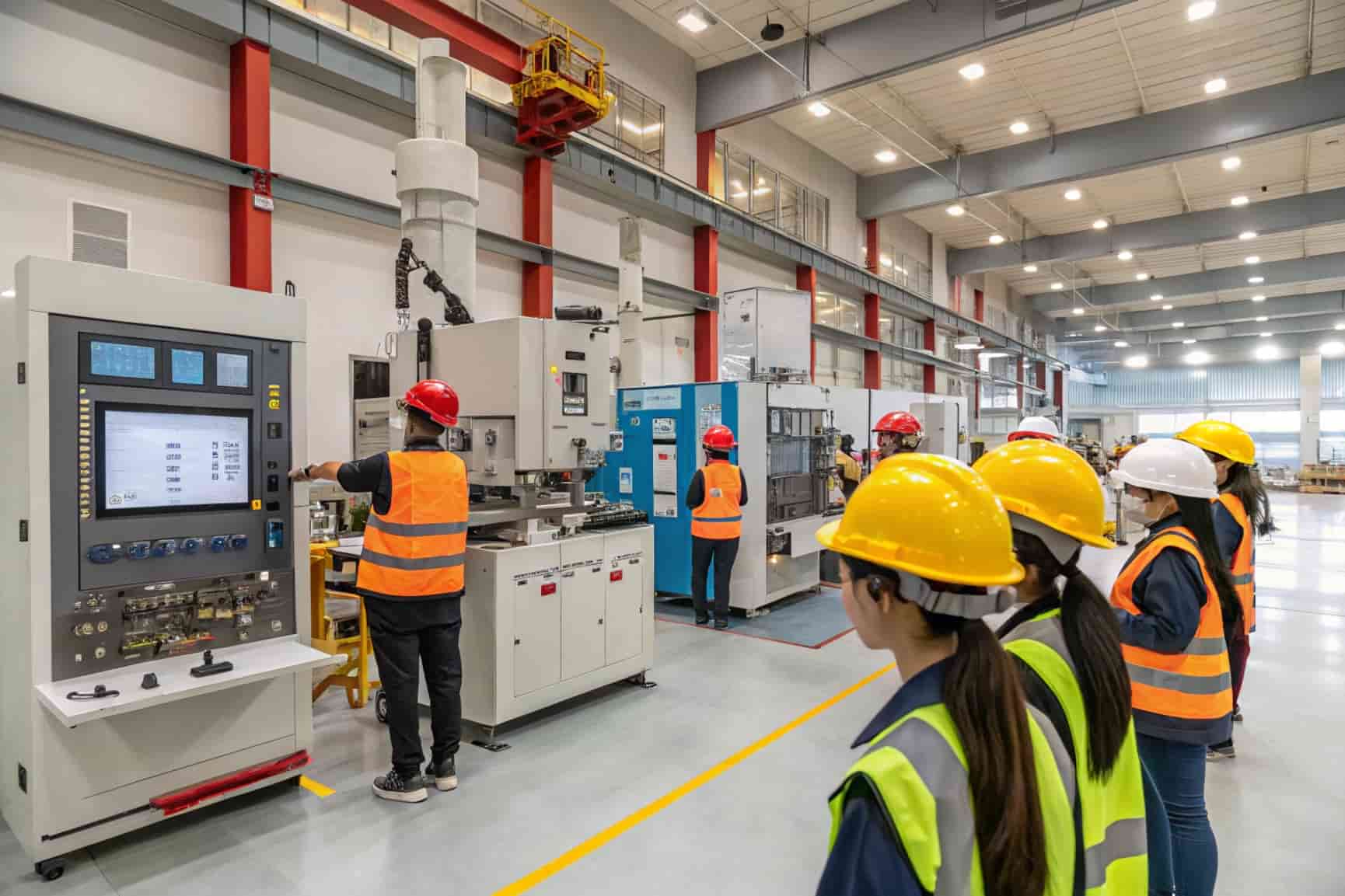In today’s competitive job market, practical experience is just as important as theoretical knowledge. Many students graduate with strong academic backgrounds but lack real-world exposure to how industries operate. This is where inplant training plays a vital role.
Inplant training provides students with hands-on industry exposure, allowing them to observe, learn, and understand professional work environments. It serves as a bridge between classroom learning and industrial applications, helping students develop technical skills, industry knowledge, and professional connections.
This article will explore everything about inplant training, including its importance, key benefits, industry applications, differences from internships, application process, and career advantages. By the end, you will understand how inplant training can help shape your career and make you job-ready.
What is Inplant Training?
Inplant training is a short-term industrial program designed to expose students to real-world industry operations. Unlike an internship, which focuses on work experience, inplant training is more about learning through observation. It helps students understand how industries function, what technologies are used, and how different departments collaborate.
This training also enhances problem-solving abilities by showing students how professionals handle real-world challenges. Additionally, it provides insights into workplace culture, helping students prepare for future careers.
Key Features of Inplant Training:
- Short Duration → Inplant training typically lasts 1 to 4 weeks, making it ideal for students who want quick industrial exposure without long-term commitments. This short-term format ensures focused learning while accommodating academic schedules and other coursework.
- Industry Exposure → Students get firsthand insights into real-world business operations, workflows, and corporate environments. They observe how industries function, how teams collaborate, and how theoretical knowledge is applied in practice, giving them a better understanding of professional settings.
- Skill Development → Inplant training helps students learn industry-specific tools, software, and techniques. By interacting with professionals, students gain technical skills, problem-solving abilities, and industry knowledge, which can help them stay ahead in their careers.
- No Direct Work Responsibilities → Unlike internships, inplant training focuses on observation and learning rather than assigning job tasks. Students are not expected to handle projects or workloads, allowing them to absorb knowledge without work pressure.
- Boosts Career Readiness → By gaining practical exposure, students become more confident and job-ready. They develop an understanding of workplace expectations, professional behavior, and industry demands, making them better prepared for internships, job applications, and long-term career success.
Difference Between Inplant Training and Internship:
Many students confuse inplant training with internships, but they serve different purposes.
Key Differences Between Inplant Training and Internship:
| Aspect | Inplant Training | Internship |
| Duration | 1-4 weeks | 3-6 months |
| Objective | Learning & Observation | Practical Work Experience |
| Workload | No specific tasks, just training | Assigned roles & projects |
| Exposure | Industry-wide overview | Department-focused work |
| Outcome | Understanding industry processes | Hands-on job experience |
Which One Should You Choose?
If you are in the early years of your degree, inplant training is a great way to explore industries. If you are looking for practical work experience, an internship would be more beneficial. Inplant training helps students gain industrial exposure, while internships provide hands-on job experience.
If your goal is to understand how industries function and observe professionals in action, inplant training is ideal. However, if you want to work on real projects and build job-specific skills, an internship is the better choice.
Why is Inplant Training Important for Students?
Gain Real-World Industry Exposure:
Many students struggle to apply classroom knowledge in real-world situations. That’s why inplant training is so valuable—it introduces them to industry environments, operational workflows, and workplace culture. By seeing how professionals work, students gain confidence, practical insights, and a better understanding of their future careers.
Develop Practical Skills:
It’s one thing to learn from textbooks, but real learning happens through experience. Inplant training allows students to observe and understand how tools, machinery, and software are used in the industry. Through industrial visits, expert guidance, and live demonstrations, they get hands-on exposure that enhances their technical skills.
Improve Career Opportunities:
Employers always look for candidates with real-world experience. Adding inplant training to your resume shows initiative, industry exposure, and a willingness to learn. This sets you apart from other job seekers and increases your chances of landing internships, full-time jobs, or higher studies in your chosen field.
Build Professional Networks:
Career success isn’t just about skills—it’s also about who you know. Inplant training helps students connect with professionals, industry mentors, and HR managers. These connections can provide valuable career guidance, job recommendations, and internship opportunities, making it easier to transition from student life to the workplace.
Also read: Best Ways to Manage Your Finances As a College Student
Bridge the Gap Between Theory and Practice:
Many students feel lost when they enter the workforce because they haven’t applied their knowledge in real scenarios. Inplant training bridges this gap by showing how academic concepts work in real industries. This makes learning more meaningful and prepares students for the challenges of professional life.
Industries That Offer Inplant Training:
Information Technology (IT) Industry:
The IT industry offers inplant training in programming, cybersecurity, and networking, helping students gain exposure to software development, system security, and database management. It provides hands-on experience with coding languages, cloud computing, and IT infrastructure, making students better prepared for careers in software engineering, IT support, and cybersecurity.
Mechanical & Manufacturing Industry:
Inplant training in this field focuses on industrial automation, robotics, and quality control, allowing students to understand production processes, material testing, and machinery operations. Training covers engineering design, manufacturing workflows, and maintenance techniques, helping students develop the skills needed for mechanical engineering, industrial production, and quality assurance roles.
Electronics & Electrical Industry:
Students in this industry learn about circuit design, PCB manufacturing, and renewable energy systems. Inplant training includes exposure to power generation, electrical grids, and embedded systems, enabling students to understand how electrical components function in modern industries. This prepares them for careers in electronics engineering, power distribution, and automation.
Civil & Construction Industry:
Inplant training in the civil sector provides insights into structural engineering, land surveying, and construction materials. Students observe building design, site planning, and infrastructure development, gaining practical knowledge of urban planning, bridge construction, and sustainable architecture. This hands-on experience helps in careers like civil engineering and project management.
Healthcare & Pharmaceuticals:
Students interested in healthcare can gain experience in hospital management, medical equipment handling, and pharmaceutical research. Inplant training includes exposure to clinical testing, drug development, and healthcare administration, preparing students for roles in medical technology, pharmacy, and patient care services.
How to Apply for Inplant Training?
Identify Your Industry of Interest:
Choose an industry that aligns with your career goals. Research companies, training institutes, and industry programs that provide inplant training. Understanding industry trends, required skills, and learning opportunities will help you pick the best program for gaining relevant knowledge and practical exposure in your chosen field.
Prepare a Resume & Cover Letter:
A well-structured resume and cover letter increase your chances of selection. Highlight your academic background, technical skills, and enthusiasm for learning. Even for short-term training, a professional application demonstrates initiative and seriousness, making a strong impression on recruiters and potential training providers.
Also read: Jablw.Rv – Revolutionizing News Consumption!
Contact Companies & Training Institutes:
Reach out to HR departments, official websites, LinkedIn, and university placement offices for inplant training opportunities. Many industries offer structured programs, and networking with professionals or attending career fairs can further enhance your chances of finding a suitable training opportunity.
Apply Early & Follow Up:
Since inplant training slots are limited, applying as early as possible increases your chances of selection. If you don’t receive a response, send a polite follow-up email within a week to show continued interest. Persistence and professionalism can make a positive impression on recruiters.
Check College-Industry Partnerships:
Many universities collaborate with industries to offer inplant training programs. Contact your college placement cell, professors, or training coordinators to find exclusive opportunities. These partnerships often provide structured programs with reputed companies, making it easier for students to gain hands-on industry experience.
Future Plans for Applying to Inplant Training:
In the future, applying for inplant training will become more streamlined and competitive. Students will have access to AI-driven career platforms, virtual industry tours, and automated application systems, making it easier to connect with companies. Crafting personalized resumes and cover letters with industry-specific keywords will be essential to stand out.
Universities will strengthen college-industry partnerships, offering structured training programs with mentorship opportunities. Early applications and automated follow-ups will improve selection chances, ensuring students gain valuable industry experience before graduation.
FAQS:
1. What is the purpose of inplant training?
Inplant training helps students gain real-world industry exposure by allowing them to observe business operations, workflows, and technologies. It bridges the gap between theoretical learning and practical application, helping students develop technical skills, industry knowledge, and professional connections for better career opportunities.
2. Who is eligible to apply for inplant training?
Students pursuing engineering, management, arts, and science degrees can apply for inplant training. Most programs are designed for undergraduate and postgraduate students, providing them with insights into industry trends, workplace culture, and career expectations to enhance their job readiness.
3. Is inplant training paid or free?
Inplant training programs can be free or paid, depending on the company or institute. Some companies offer free training with certification, while others charge a small fee for providing industry visits, professional mentorship, and hands-on exposure to advanced tools and techniques.
4. How do I find inplant training opportunities?
Students can find inplant training through company websites, LinkedIn, college placement cells, career fairs, and industry partnerships. Networking with professionals, reaching out to HR departments, and applying early can increase the chances of securing a good training opportunity.
5. How does inplant training help in career growth?
Inplant training boosts career growth by providing practical industry exposure, skill development, and networking opportunities. It enhances a student’s resume, improves job prospects, and prepares them for internships or full-time roles by giving them firsthand insights into industry expectations and professional work environments.
Conclusion:
Inplant training is an essential step for students who want to gain real-world industry exposure before stepping into their careers. It provides a practical learning experience, bridging the gap between academic knowledge and professional applications.
By participating in inplant training, students can develop technical skills, understand workplace culture, and build valuable industry connections. Additionally, it enhances career opportunities by preparing students for internships and full-time roles. As industries continue to evolve, inplant training will play an even bigger role in shaping skilled professionals ready for the job market.




